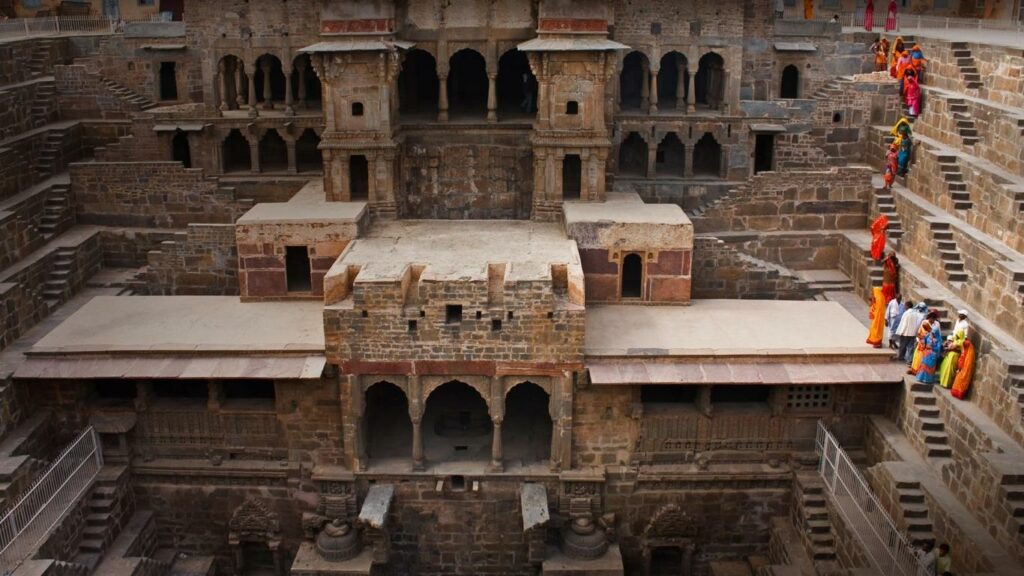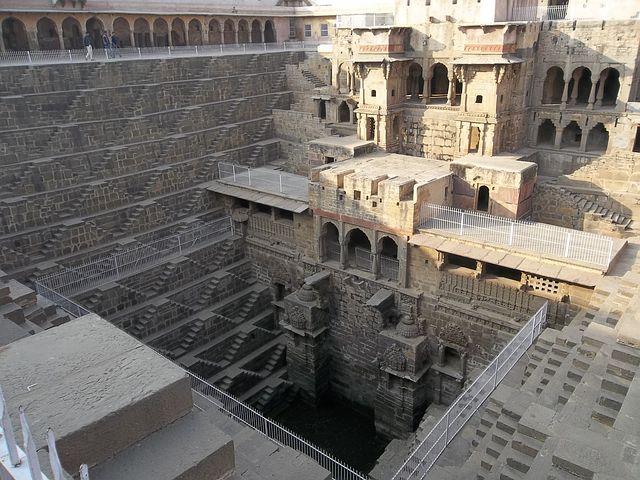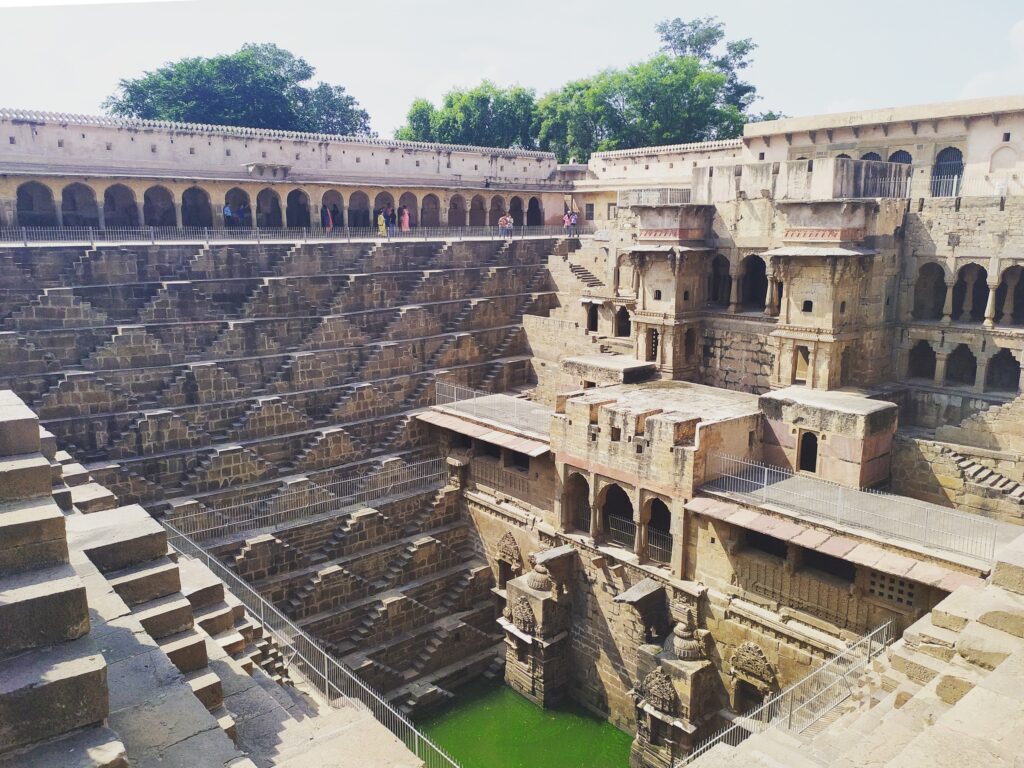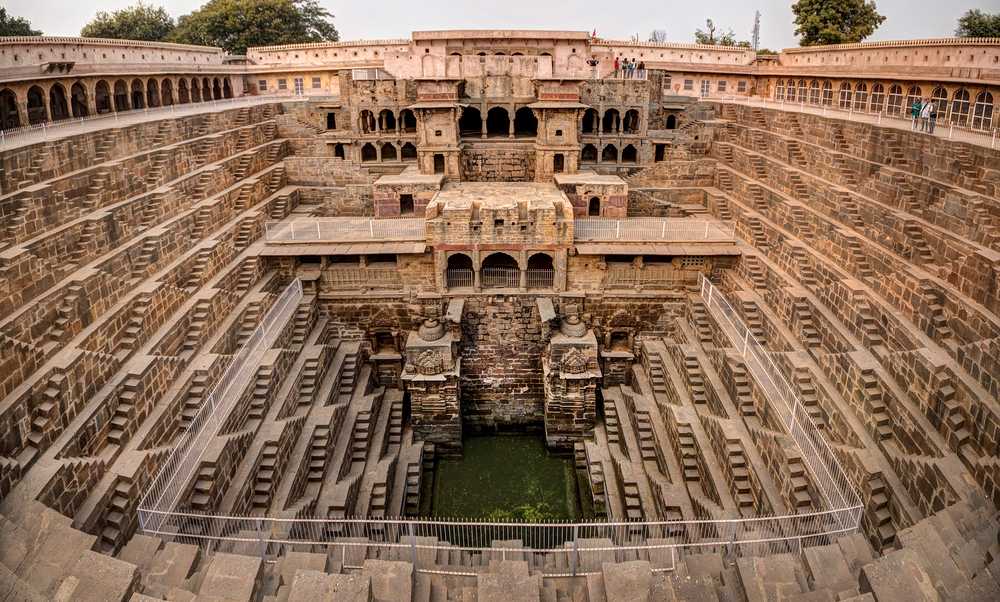The Chand Baori is a stepwell built over a thousand years ago in the Abhaneri village of Rajasthan. It is one of the largest step-wells in the world and also one of the most beautiful ones. Located in the eastern part of the province of Rajasthan, it was built by King Chanda somewhere in the 9th century. The Chand Baori is not an easy landmark to find, thus it is one of the hidden secrets of India! Stepwells also called Bawdy or Baori, are unique to this nation. The wells have steps built into the sides that lead down to the water.
As Gujarat and Rajasthan have low rainfall and are normally dry, rainwater harvesting and conservation of water were of the highest importance in these places, especially during periods of drought. Water has always played an important role in the lives of Indians, as seen in the practice of rivers being worshipped as goddesses, and so it was only natural that the places where people gathered to celebrate, bathe, or collect water for their daily needs became focal points in their lives.
The state of Rajasthan is extremely arid, and the design and final structure of Chand Baori were intended to conserve as much water as possible. At the bottom of the well, the air remains 5-6 degrees cooler than at the surface, and Chand Baori was used as a community gathering place for locals during periods of intense heat.

The steps and platforms built on the lines of rivers, known as ghats, may perhaps have been the inspiration for the baolis or baoris or vavs, as step wells are called in Rajasthan and Gujarat. These also have places of worship and cabins for relaxation attached to them.
The state of Rajasthan is extremely arid, and the design and final structure of Chand Baori was intended to conserve as much water as possible. At the bottom of the well, the air remains 5-6 degrees cooler than at the surface, and Chand Baori was used as a community gathering place for locals during periods of intense heat.
In a stepwell, there is a central, vertical shaft with water, which spreads out to a pool with a broad mouth, around which steps are built. The baoli itself can be round, rectangular, or square, and built with the simplicity or magnificence of the means at the command of the builder. The number of subterranean passages and rooms all around also depended on the same. The depth of the stepwell depended on underground water levels, and thus motivated elaborate designs for the steps. These were the precursors of exclusive clubs in ancient and medieval India where people could hang out with each other, provide hospitality to guests from out of town, and also get water for their daily needs.
This water management system was discouraged by the British who couldn’t digest the fact that the same water was used for drinking as well as washing and bathing. They already had their own exclusive clubs and smoke rooms, so they developed systems of pumps and pipes. This led to the drying up, clogging, and eventual deterioration of an ancient lifestyle.
Though north India has many baolis, with Delhi alone boasting of around 30, some of which are still functional, my heart was delighted when I visited the one in Abhaneri in Dausa district in Rajasthan. It is one of the world’s oldest, deepest, and most spectacular step wells.

Chand Baori was built during the 8th and 9th centuries and has 3,500 narrow steps arranged in perfect symmetry, which descend 20m to the bottom of the well. Centuries ago, the step wells were built in the arid zones of Rajasthan to provide water all year through. Today, the construction is not used as a well anymore but its exquisite geometry attracts local and international visitors alike.
About 64 feet deep, it is India’s largest and deepest step wells with 13 floors and was built in the 9th century for water harvesting.
Chand Baori inside view was so named as it was built by King Chand Raja from the Gujara Pratihara clan, who claim to be the descendant of Lord Ram’s younger brother Laxman. The Pratihara dynasty was at its peak during the 6th-10th century AD, and also ruled over other parts of Rajasthan. Their capital was Mandore Near Jodhpur. The baori has a precise geometrical pattern, hard to find in this age. The steps form a magical maze and the consequent play of light and shadow on the structure gives it a captivating look.
It has an enclosed rectangular courtyard kind of structure. Upon entering you reach a jharokha (windows). Descending the stairs on the left, you can see the cavernous baori narrowing towards the bottom, crisscrossed with double flights of steps on three sides to reach the water surface down below.
The baori was attached to the Harshat Mata temple. It was a ritual to wash hands and feet at the well before visiting the temple. The temple was razed during the 10th century, but its remains still boast the architectural and sculptural styles of ancient India. Harshat Mata is considered to be the goddess of happiness, always imparting joy to the whole village.
Now there are railings, and so we can’t go down the steps. But the temperature at the bottom is five-six degrees cooler and must have provided solace during the hot summer days and nights to the locals.

Later, the Mughals added galleries and a compound wall around the well. Today, this house the remains of exquisite carvings, which were either in the temple or in the various rooms of the baoli itself. The Chand Baori is one of the few step wells, or rather step pond as Morna Livingston writes in Steps to Water: The Ancient Stepwells of India, that showcases “two classical periods of water building in a single setting.”
An upper palace building was added to one side of the baoli, which can be seen from the trabeated arches used by the Chauhan rulers and the cusped arches used by the Mughals.
The stairs encircle the water on the three sides while the fourth side boasts of a pavilion with three stories with beautifully carved jharokhas, galleries supported on pillars, and two projecting balconies enshrining beautiful sculptures.
Tags: Stepwells, Periods of drought, water management system, structure, Geometrical Pattern, The Ancient Stepwells of India.

